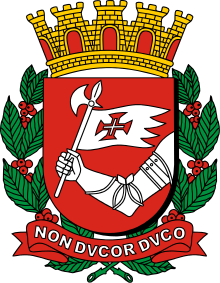Line 18 (São Paulo Metro)
| São Paulo Metro Line 18 – Bronze | |
|---|---|
 | |
| Overview | |
| Type | Monorail |
| System | São Paulo Metro |
| Status | In planning |
| Locale | [1] |
| Termini |
Tamanduateí[1] Djalma Dutra[1] |
| Stations | 13[1] |
| Daily ridership | 314,000 (estimated)[1] |
| Operation | |
| Opened | in planning |
| Owner | Companhia do Metropolitano de São Paulo |
Line 18 – Bronze is a future project of the São Paulo Metro. It will link São Paulo to the southeast portion of the Greater São Paulo, ending in São Bernardo do Campo. The line is expected to be the first São Paulo Metro Line to go beyond the city limits.[1][2]
Background
Preliminary studies for a city passenger rail transportation system in São Paulo were sketched as of 1888,[3] and later some of them included the so-called ABC region. One of them cited a suspension railway as an alternative for the city and its neighborhoods in the 1960s, inspired on Wuppertal Suspension Railway and SAFEGE models, including a suggestion to link ABC to Parque Dom Pedro II through Tamanduateí River.[4] São Paulo Metro was established as a company in 1968 and started its revenue service in 1974.[5] Its justification was based upon the fast growth of the city of São Paulo, and its car fleet as well, with all the problems emerging due to that. The original plan suggested the construction of four lines, all of them enclosed within the city's limits, although predicting transfer stations to the commuter rail system and the buses. The southeasternmost station of the system was predicted to be settled near Via Anchieta (and bearing such name), a state road linking São Paulo to Santos passing by the ABC region.[6] Although commuter rail services exist between the ABC region and the city of São Paulo since the end of the 19th century, through São Paulo Railway and its successors, the fast growth of the area observed in the 2nd half of the 20th century and the unavailability of such services in some cities (notably São Bernardo do Campo and Diadema) demanded further transport options to the region. At first the government didn't see any rationale to establish a metro line in the area, choosing to install a trolley bus service linking São Paulo to São Bernardo do Campo through Diadema.[7] Such initiatives led to the establishment of São Mateus–Jabaquara Metropolitan Corridor, one of the first bus rapid transit systems in Brazil.
The São Paulo secretariat of Metropolitan Transportation started to issue plans for the future transport expansion in 1997, aiming to anticipate and get prepared for the demands of its citizens on this matter. Those reports are known as Integrated Urban Transport Plans (Plano Integrado de Transporte Urbano – PITU).[8] PITU 2025 claimed for the need to a metro branch linking ABC to São Paulo, more specifically employing either a light rail or guided bus technology.[9]
Project
| Line 18 – Bronze [10][11] | |||||||||||||||||||||||||||||||||||||||||||||||||||||||||||||||||||||||||||||||||||||||||||||||||||||||||||||||||||||||||||||||||||||
|---|---|---|---|---|---|---|---|---|---|---|---|---|---|---|---|---|---|---|---|---|---|---|---|---|---|---|---|---|---|---|---|---|---|---|---|---|---|---|---|---|---|---|---|---|---|---|---|---|---|---|---|---|---|---|---|---|---|---|---|---|---|---|---|---|---|---|---|---|---|---|---|---|---|---|---|---|---|---|---|---|---|---|---|---|---|---|---|---|---|---|---|---|---|---|---|---|---|---|---|---|---|---|---|---|---|---|---|---|---|---|---|---|---|---|---|---|---|---|---|---|---|---|---|---|---|---|---|---|---|---|---|---|---|
| |||||||||||||||||||||||||||||||||||||||||||||||||||||||||||||||||||||||||||||||||||||||||||||||||||||||||||||||||||||||||||||||||||||
The original project predicted an 18 stops' line linking the current Tamanduateí station (already served by São Paulo Metro and CPTM commuter rail service as well) to Alvarengas station, a future terminal station to be located near the city road bearing the same name.[12] However parts of such path overlaps the current São Mateus–Jabaquara metropolitan corridor, which would demand the extinction of such service between São Bernardo and Ferrazópolis. As this corridor is operated through a concession, it would imply breaking that contract thus exposing the state government to a termination fee. Such risk endangered the whole project[13] and the solution sought was to truncate the proposed line to end at São Bernardo station and eventually at Djalma Dutra station.
The government procurement for the establishment of the line has been established in 2014 and states it will be constructed as a public–private partnership. The system is expected to be concluded in 2018.[14] Stations Rudge Ramos and Mauá are shown as Praça Regina Matiello and Instituto Mauá, respectively, in some local news sources,[11][15] although the most recent metro company documents still don't mention them bearing such names.[16]
In July 2014, Malaysian rail company Scomi Rail announced that it had been selected as the monorail technology provider for the winning consortium of the Public Private Partnership Project (PPP), Consorcio ABC Integrado. This would be Scomi's third project in Brazil after the Line 17 (São Paulo Metro) and the Manaus Monorail.[17] The line will operate the Scomi SUTRA monorail systems designed by Scomi Rail.
Controversy
The monorail alternative for line 18 was contested, as it is not employed on current metro branches but appointed as the most suitable construction for this project, as well as for lines 15 (formerly line 2 expansion) and 17. Positive arguments are the cheaper, faster construction and decreasing the need for resumption; listed setbacks are visual pollution, difficulty to be evacuated in case of emergency, its relative small capacity and incapability to be upgraded.[18] In downtown São Bernardo do Campo, some real estate owners tried to settle a civil action to change the proposed right-of-way, as it may adversely affect high-end apartment buildings recently erected there, through aesthetic concerns and planned resumptions.[19]
References
- 1 2 3 4 5 6 "Linha 18 vai gerar 1000 empregos diretos" [Line 18 will generate 1,000 direct jobs]. Diário do Grande ABC website (in Portuguese). January 30, 2014. Retrieved March 11, 2014.
- ↑ Ribeiro, Bruno (February 3, 2012). "Governo quer terceirizar o monotrilho do ABC" [Government wants to outsource ABC monorail]. O Estado de S. Paulo (in Portuguese). p. C8. Retrieved March 15, 2014.
- ↑ "Em 1888, engenheiro alemão tentou – sem sucesso – fazer monotrilho no centro" [In 1888, a German engineer tried – unsuccessfully – to build a monorail downtown]. O Estado de S. Paulo (in Portuguese). January 25, 2013. p. H4. Retrieved March 13, 2014.
- ↑ "Preconizado o metro aéreo como solução para a Capital" [Predicting elevated metro as a solution for the capital]. O Estado de S. Paulo (in Portuguese). January 2, 1966. p. 20. Retrieved March 13, 2014.
- ↑ "About Us". São Paulo Metro website. Retrieved March 12, 2014.
- ↑ de Siqueira, Ethevaldo Mello (November 21, 1968). "Passageiros, o metro já vai partir" [Passengers, the metro will depart]. O Estado de S. Paulo (in Portuguese). p. 90. Retrieved March 12, 2014.
- ↑ "Obras de trólebus no ABC começam este ano" [Trolley bus works start this year]. O Estado de S. Paulo (in Portuguese). November 30, 1984. p. 36. Retrieved March 12, 2014.
- ↑ "PITU Presentations". Metropolitan Transportation Secretary website. August 9, 2009. Retrieved March 14, 2014.
- ↑ "PITU 2025" (PDF). São Paulo Secretariat of Metropolitan Transportation (in Portuguese). December 2006. p. 196. Retrieved March 17, 2014.
- ↑ Santiago, Tatiana (January 28, 2014). "Governo publica nesta quarta edtal para monotrilho que liga capital a ABC" [Government issues procurement for monorail to link the capital to ABC region]. g1.com.br (in Portuguese). Retrieved March 18, 2014.
- 1 2 Lobo, Renato (January 29, 2014). "Confira detalhes da Linha 18 – Bronze, que teve edital de obras lançado nesta quarta (29)" [Check out details from line 18 – Bronze, whose procurement has been issued on this Wednesday 29]. viatrolebus.com.br (in Portuguese). Retrieved March 19, 2014.
- ↑ "Estudo de Impacto Ambiental – Linha 18" [Environmental impact assessment – Line 18] (PDF). São Paulo Metro website (in Portuguese). May 15, 2012. p. 1. Retrieved March 17, 2014.
- ↑ Rocha, Rafael (June 23, 2013). "Linha 18 – Bronze até o Alvarenga tem chance de ficar só no papel" [Line 18 – Bronze to Alvarenga in risk to remain as a project]. Diário do Grande ABC website (in Portuguese). Retrieved March 17, 2014.
- ↑ Rocha, Raphael (January 29, 2014). "Alckmin planeja divulgar vencedor da Linha 18 no 1º semestre" [Alckmin plans to announce line 18 winner up to the 1st half-year]. Diário do Grande ABC website (in Portuguese). Retrieved March 17, 2014.
- ↑ "A evolução das obras do metro e CPTM" [Evolution of Metro and CPTM works]. terra.com.br (in Portuguese). Retrieved March 19, 2014.
- ↑ "Desapropriações – Linha 18 Bronze" [Resumptions – Line 18 Bronze]. São Paulo Metro website (in Portuguese). Retrieved March 19, 2014.
- ↑ "Scomi" (PDF). Retrieved 15 April 2015.
- ↑ Brancatelli, Rodrigo; Cavaleiro, Carolina; Müller, Marcos (March 19, 2012). "O monotrilho é uma boa ou má opção para SP?" [Is monorail a good or bad option for São Paulo?]. O Estado de S. Paulo (in Portuguese). p. C6. Retrieved March 14, 2014.
- ↑ Santiago, Tatiana (July 8, 2013). "Moradores querem ação judicial contra traçado de monotrilho no ABC" [Homeowners want civil action against ABC monorail path]. g1.com.br (in Portuguese). Retrieved March 17, 2014.
